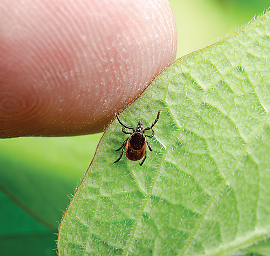Case Shows How Lyme Disease Can Mimic New-Onset Panic Disorder
Abstract
Neuropsychiatric symptoms are commonly misdiagnosed, and delayed treatment for the real cause can lead to long-lasting impairment.
Syphilis, caused by the spirochete bacterium Treponema pallidum, has been called the “great imitator” because of its ability to affect numerous systems and confusion with other diseases. At a workshop at APA’s 2013 annual meeting titled “Medical Conditions Mimicking Psychiatric Disorders Versus Psychiatric Disorders Mimicking Medical Conditions: Diagnostic and Treatment Challenges,” presenter Yu Dong, M.D., Ph.D., a psychiatry resident at Baystate Medical Center in Springfield, Mass., detailed the case of another spirochetal imitator: Borrelia burgdorferi, the Lyme disease bacterium.

The bite of an Ixodes tick can potentially lead to a host of neuropsychiatric symptoms.
Dong shared with a packed room the case of a 19-year-old female college sophomore who suffered neuropsychiatric manifestations of early-stage Lyme disease. The patient experienced sustained panic attacks lasting for hours at a time and severely disturbed sleep, and she described a “brain fog” that caused difficulty with concentration and memory and left her feeling detached from reality. She also experienced “stroke-like” symptoms that included blurred vision, facial tingling, and left-sided body numbness. Despite the occurrence of these symptoms within a month after she was exposed to a tick at a baseball field in May 2012, the patient had four negative Lyme test (ELISA) results.
Her symptoms continued for several months, as she was given a cardiac workup, which was negative, and a neurologic workup including head CT and MRI of the cervical spine. Results of the neurologic workup—intended to assess whether she might be experiencing a viral CNS infection or atypical migraine—were negative as well. In September, she experienced joint pain and swelling. In December, six months after her symptoms had begun, a Lyme disease specialist performed a Western blot test, finding her positive for three out of 10 bands, and she was finally diagnosed with Lyme disease.
Treatment was begun, but the patient’s medical odyssey was not yet over.
Despite treatment, her symptoms worsened, with more frequent panic attacks and nighttime awakening attributed to Herxheimer reaction. A Herxheimer reaction is worsening of symptoms during the first few days of antibiotic treatment, presumably due to an inflammatory response to spirochetal lysis and antigen release, explained Dong, who noted that such a reaction can be quite prolonged in cases of Lyme disease.
“Patients who are treated with appropriate antibiotics in the early stages of Lyme disease usually recover rapidly and completely,” Dong noted, “but antibiotic treatment may be less effective in the late stages of illness,” making rapid diagnosis imperative to prevent long-term consequences for the patient. Treatment in the late or chronic stage is difficult due to sequestration of the spirochete, especially in the CNS. Untreated infection leads to recurrence of fluctuations of symptoms, triggering specific or nonspecific immunologic responses that can become multisystem symptoms. Neuropsychiatric symptoms may become permanent and irreversible, either from the direct effect of the spirochete in the CNS or from a secondary immune response.
Dong said Lyme disease is just one of several medical conditions that can mimic panic disorder—myocardial infarction, cardiac dysrhythmia, asthma, hyperthyroidism, pheochromocytoma, and seizure disorder are some of the others.
Lyme disease can be easily missed as a diagnosis because a patient may not have a history of tick exposure or experience the characteristic skin rash, and the multisystem nature of the disease can lead to multiple diagnoses for the patient’s symptoms. Latent asymptomatic infection with Borrelia burgdorferi can also last years before symptoms of late infection appear. When Lyme disease is suspected, two-tiered testing (ELISA and Western blot) is recommended, and “most literature recommends clinical diagnosis regardless of serology findings,” said Dong. ■



